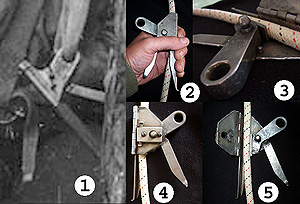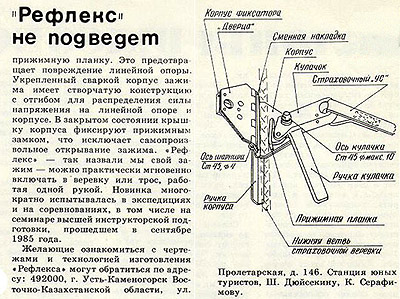Technical Details
I acquired my Reflex from Konstantin Serafimov in 2007.
My Reflex is 137 mm. tall, 86 mm. wide, 30 mm. thick, and
weighs 278 g. The shell is made from 1.9 mm. stainless steel,
and consists of two assemblies hinged together to form, when closed,
a square-based rope channel. The piece forming the rear and right
side of the channel is 41 mm. wide and 68 mm. high,
with an additional 68 mm. extension welded to its base. The
cam axle is permanently attached the upper section, and a small
stop pin prevents over-opening the cam. The left side plate swings
open on a hinge. A hole allows the left side plate to close over
the cam axle. A pair of spring-loaded levers held under a screwed-on
cover plate operate in scissors-fashion to engage a groove in
the cam axle.
The cam is cut from a piece of 12 mm. stainless steel. The cam
has a flat face that pivots on a 6 mm. pin set in the cam
toe. The cam face is 36 mm. high, and is flat except for
the top and bottom 3 mm. which are each well-rounded. A 72 mm.
length of 6 mm. rod is welded to the base of the cam.
The only markings on this Reflex is a large "2" stamped
in the cam.
Konstantin Serafimov invented the Reflex after surviving an
out-of-control "grabbed ascender" incident. After seeing
the Levistan, Version B ascender
on my web site, he had a friend of his make this Reflex for me.
As he said,
I sure you already understand - "Reflex"
is universal cable/rope self-belay ascender. And principle of
it’s operation founded on applying "panic-reflex,"
when the victim instinctively grabbed the ascender.
As I wrote, I think up principle "reflex
self-belay ascender" after my descent with grabbed "gibbs"
in the cave Kutuk-Soumgan in 1980 and series tests like Don Davison’s
and Dan Meier’s three-rope rig, in 1981-82.
Since 1983 many my friends, cavers of
my club "Soumgan" and other soviet caving clubs made
and used different ascenders of "positive reflex-action"
- as "Leviston-B," and I don't know accidents with this
devices, never a one.
 Konstantin’s approach to rappel safety differs from mine, but I think his is practical, provided
one always grabs below the ascender.
Konstantin’s approach to rappel safety differs from mine, but I think his is practical, provided
one always grabs below the ascender.
Konstantin
sent me some pictures showing his Reflex ascender from 1983, which
I edited slightly. There are five views:
- Reflex made from a Soviet version of the Gibbs.
- Konstantin’s Reflex, showing the "positive reflex action"
engaged by grabbing the lower portion of the ascender
- Open. See how the cam axle is turned to provide for quickly
closing and latching the side plate.
- The Reflex on rope.
- The Reflex, open to show the internals.
 The flat cam face will allow the Reflex to slip under shock loads,
but it seems to be adequate for normal loads. The extensions that
provide "positive reflex action" considerably and unfortunately
increase the ascender’s size. The latch mechanism is clever. Mine
has some rough edges that make opening the ascender a bit awkward,
but closing is quite smooth. Unfortunately, the fine mechanism
is subject to jamming in dirty conditions, especially in sandy
mud.
The flat cam face will allow the Reflex to slip under shock loads,
but it seems to be adequate for normal loads. The extensions that
provide "positive reflex action" considerably and unfortunately
increase the ascender’s size. The latch mechanism is clever. Mine
has some rough edges that make opening the ascender a bit awkward,
but closing is quite smooth. Unfortunately, the fine mechanism
is subject to jamming in dirty conditions, especially in sandy
mud.
The Levistan, Version B was almost certainly
a copy of the Reflex. Konstantin published his concept in
the Moscow journal Tourist in 1986.
Konstantin has some additional information on his
web site, including, with my permission, a Russian translation
of my Rappel Safeties
Internet Post.

For far more content, use a larger monitor and a full-width window.
Hundreds of cell phone users complained and asked me to for a simpler, mobile friendly site. In particular, they wanted me to limit each page to a small number of pictures and minimize my use of text. This new site provides what they asked for.


 Konstantin’s approach to rappel safety differs from
Konstantin’s approach to rappel safety differs from 